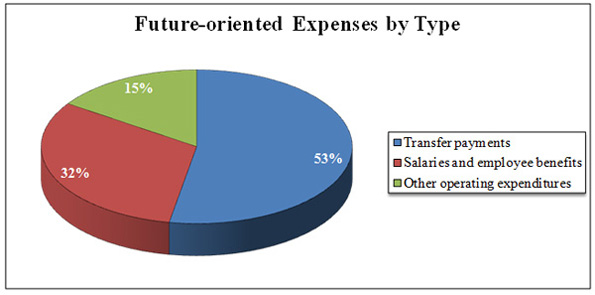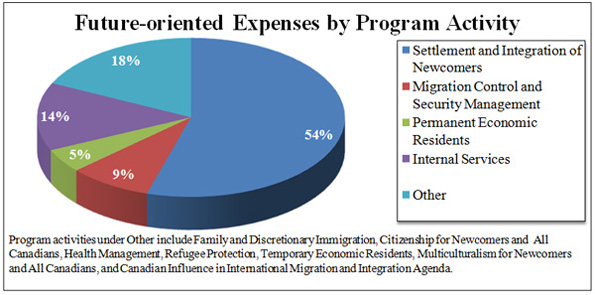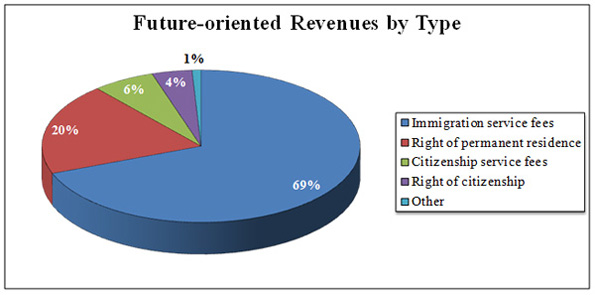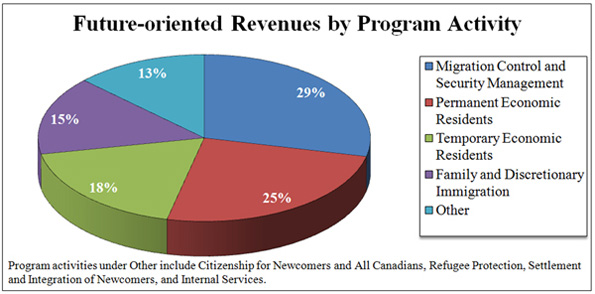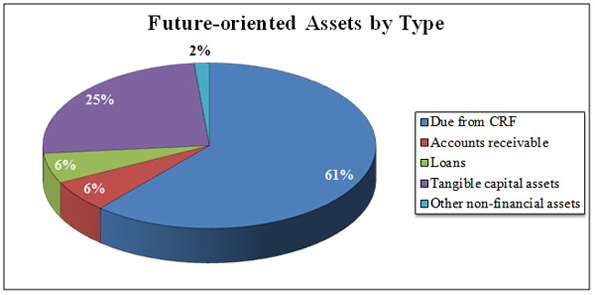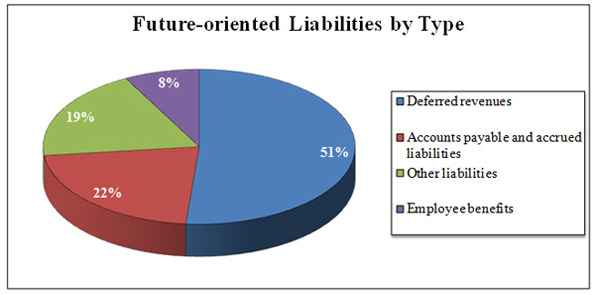Common menu bar links
Breadcrumb Trail
ARCHIVED - Citizenship and Immigration Canada - Report
 This page has been archived.
This page has been archived.
Archived Content
Information identified as archived on the Web is for reference, research or recordkeeping purposes. It has not been altered or updated after the date of archiving. Web pages that are archived on the Web are not subject to the Government of Canada Web Standards. As per the Communications Policy of the Government of Canada, you can request alternate formats on the "Contact Us" page.
Section III - Supplementary Information
Financial Highlights
The future-oriented financial highlights presented within this Report on Plans and Priorities are intended to serve as a general overview of CIC’s financial position and operations. These future-oriented financial highlights are prepared on an accrual basis and contribute to strengthening accountability and improving transparency and financial management.
| $ Change | Future-Oriented 2012-13 |
Future-Oriented 2011-12 |
|
|---|---|---|---|
| EXPENSES | |||
| Transfer payments | 0 | 962 | 962 |
| Salaries and employee benefits | 8 | 576 | 568 |
| Other operating expenditures | -62 | 283 | 345 |
| Total Expenses | -54 | 1,821 | 1,875 |
| REVENUES | |||
| Immigration service fees | -2 | 305 | 307 |
| Right of permanent residence | -8 | 86 | 94 |
| Citizenship service fees | 4 | 28 | 24 |
| Right of citizenship | 0 | 18 | 18 |
| Other | 0 | 4 | 4 |
| Total Revenues | -6 | 441 | 447 |
| Net Cost of Operations | -48 | 1,380 | 1,428 |
Contributing to the reduction in total expenses is the creation of Shared Services Canada.
Expenses by Type
Figure 3 outlines CIC’s future-oriented expenses by type for 2012–2013:
Expenses by Program Activity
Figure 4 outlines CIC’s future-oriented expenses by program activity for 2012–2013:
Revenues by Type
Figure 5 outlines CIC’s future-oriented revenues by type for 2012–2013:
Revenues by Program Activity
Figure 6 outlines CIC’s future-oriented revenues by program activity for 2012–2013:
Please note that the variance between the future-oriented net cost of operations and the planned spending amounts provided in other sections of the RPP is mainly due to adjustment for non-respendable revenues and refunds of previous years’ revenues, services provided without charge by other government departments, acquisition and amortization of tangible capital assets, severance and vacation pay liability adjustments and changes in inventory and prepaid expenses.
| $ Change | Future-Oriented 2012-13 |
Future-Oriented 2011-12 |
|
|---|---|---|---|
| ASSETS | |||
| Financial assets | 11 | 408 | 397 |
| Non-financial assets | -12 | 147 | 159 |
| Total assets | -1 | 555 | 556 |
| LIABILITIES | |||
| Total liabilities | 6 | 765 | 759 |
| EQUITY | -7 | (210) | (203) |
| Total Liabilities and Equity | -1 | 555 | 556 |
Assets by Type
Total assets for 2012–2013 are projected to be $555 million. CIC’s largest asset is $341 million due from the Consolidated Revenue Fund (CRF), mainly projected payables at year end and liabilities related to the Immigrant Investment Program. Non-financial assets include the development costs related to the Global Case Management System.
Figure 7 outlines CIC’s future-oriented assets by type for 2012–2013:
Liabilities by Type
Total liabilities for 2012–2013 are projected to be $765 million. Deferred revenue is estimated to represent approximately 51% of total liabilities. The deferred revenue account was established to record fees and rights derived from the Citizenship Act and Regulations and the Immigration and Refugee Protection Act and Regulations. Fees are deferred until an application is deemed processed, while fees for rights (right of citizenship and right of permanent residence) are deferred until the right is granted.
Figure 8 outlines CIC’s future-oriented liabilities by type for 2012–2013:
Future-Oriented Financial Statements
CIC’s complete future-oriented financial statements can be found on its Web site.
Supplementary Information Tables
All electronic supplementary information tables found in the 2012–13 Reports on Plans and Priorities can be found on the Treasury Board of Canada Secretariat website.
- Details on Transfer Payment Programs;
- Greening Government Operations;
- Sources of Respendable and Non-Respendable Revenue;
- Status Report on Transformational and Major Crown Projects;
- Up-Front Multi-Year Funding; and
- Upcoming Internal Audits and Evaluations over the next three fiscal years.
Section IV - Other Items of Interest
Organizational Contact Information
For any additional information, on this report or other parliamentary reports for CIC, please contact ParliamentaryReports-RapportsParlementaires@cic.gc.ca.
Gender-based Analysis
Under the Immigration and Refugee Protection Act, CIC is accountable to Parliament for conducting gender-based analysis (GBA) on the impact of the Act and its regulations. A new departmental policy on GBA has been approved and will apply across all of CIC’s business lines, from policy development to program implementation. Several initiatives have been selected as models of good practice at different stages of the policy and program development cycle. For example, GBA will continue to be applied in the performance measurement framework for refugee reform. It will also be incorporated into the Interim Federal Health Program review, as well as in the monitoring of pass rates for the citizenship test. As in the past, GBA will be supported by CIC’s data-management activities, which will contribute to the development and dissemination of gender-based research. For more information on CIC’s plans and activities with respect to GBA, consult the Department’s annual reports to Parliament on immigration.
Quarterly Financial Reports
Canadians expect the federal government to manage public funds well by effectively planning, budgeting and making decisions on the allocation, reallocation and use of financial and other resources based on reliable information and sound analysis of that information. They also expect timely and reliable reporting that provides transparency and accountability for how government spends public funds to achieve results for Canadians.
Quarterly financial reports were introduced, government-wide, in 2011–2012. These quarterly reports are completed on an expenditure basis of reporting and prepared using a special-purpose financial reporting framework designed to meet financial information needs and to assist in the timely and effective oversight of government expenditures. Each report includes a minimum of two sections. The first is a signed statement outlining results, risks and significant changes related to operations, personnel and programs. The second section contains quarterly financial information incorporating a Statement of Authorities and a table of departmental budgetary expenditures for both the quarter and the fiscal year-to-date with comparative financial information for the preceding fiscal year. The reports are made public within 60 days of the end of each reporting period.
Research Activities
CIC’s research program provides expert evidence-based support for policy development, program monitoring, performance measurement and evaluation. The research program enhances the Department’s intellectual capital and knowledge base for systematic application of evidence-based analysis and research. The program also facilitates data sharing and reporting service commitments to internal and external partners and stakeholders, including the Canadian public. In 2012–2013, CIC plans to:
- continue research aligned with departmental strategic objectives to inform key policy questions related to immigration levels and optimum mix; immigrant and refugee labour market participation and economic outcomes; social integration; and diversity, multiculturalism and social inclusion;
- support departmental service modernization by improving data content scope, streamlining data-sharing delivery mechanisms and exploiting new communications channels;
- complete systematic integration of research and evaluation functions with policy and program development and monitoring;
- streamline performance measurement for enhanced program monitoring and evaluation; and
- expand research partnerships with other federal government departments, provinces and territories, and non-governmental research networks.
Notes
i. Type is defined as follows: previously committed to—committed to in the first or second fiscal year prior to the subject year of the report; ongoing—committed to at least three fiscal years prior to the subject year of the report; and new—newly committed to in the reporting year of the RPP.
ii. Irregular migration refers to individuals who have migrated from one country to another with no legal recognition of their right to do so.
iii. The four population groups are: visible minority and foreign-born; non-visible minority and foreign-born; visible minority and Canadian-born; and non-visible minority and Canadian-born.
iv. Based on 2010 public opinion research (Annual Tracking Survey 2010), 22% of immigrants, 21% of Canadian-born, 23% of visible minorities and 21% of non-visible minorities agree that to “be a good person/citizen and practise good citizenship/values” is one of the top three responsibilities of citizenship. Moreover, 80% of immigrants, 66% of Canadian-born, 76% of visible minorities and 69% of non-visible minorities agree that “Ethnic background is a defining and enriching part of our Canadian identity.”
v. The ongoing impact of the strategic review of CIC spending was an overall reduction of $67.6 million per year primarily in settlement programs, operational efficiencies, and language selection and testing.
vi. Foregone revenue is the estimated reduction in revenue to the Government of Canada when decisions are taken to reduce fees, such as the removal of visa requirements. Foregone revenue impacts are treated as reductions to CIC’s operating budget.
vii. Percentage of economic immigrants over age 15 intending to work as a proportion of net labour force growth.
viii. To alleviate the burden on new applications and to reduce the 165,000-strong backlog of parent and grandparent applicants, on November 5, 2011, CIC suspended acceptance of new sponsorship applications for up to 24 months.
ix. The multiple-entry visa allows an applicant to remain in Canada for up to 24 months at a time without the need to renew their status. Super visas are issued, on average, within eight weeks of application, which means that instead of waiting for eight years, a parent or a grandparent can come to Canada within eight weeks. Super visa applicants are required to obtain private Canadian health insurance for their stay in Canada.
x. Newcomers are defined as immigrants who have been in Canada for less than 10 years.

